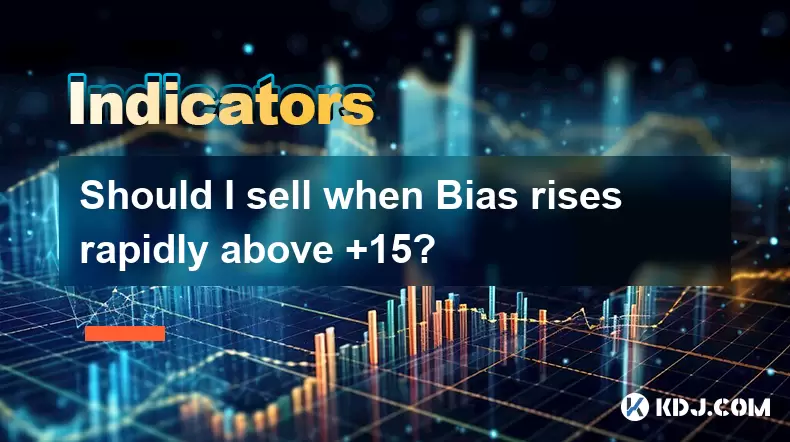-
 bitcoin
bitcoin $87959.907984 USD
1.34% -
 ethereum
ethereum $2920.497338 USD
3.04% -
 tether
tether $0.999775 USD
0.00% -
 xrp
xrp $2.237324 USD
8.12% -
 bnb
bnb $860.243768 USD
0.90% -
 solana
solana $138.089498 USD
5.43% -
 usd-coin
usd-coin $0.999807 USD
0.01% -
 tron
tron $0.272801 USD
-1.53% -
 dogecoin
dogecoin $0.150904 USD
2.96% -
 cardano
cardano $0.421635 USD
1.97% -
 hyperliquid
hyperliquid $32.152445 USD
2.23% -
 bitcoin-cash
bitcoin-cash $533.301069 USD
-1.94% -
 chainlink
chainlink $12.953417 USD
2.68% -
 unus-sed-leo
unus-sed-leo $9.535951 USD
0.73% -
 zcash
zcash $521.483386 USD
-2.87%
Should I sell when Bias rises rapidly above +15?
A rapid rise in the Bias indicator above +15 signals strong bullish momentum in crypto, suggesting either trend continuation or potential overbought conditions.
Jun 17, 2025 at 08:21 am

Understanding the Bias Indicator in Cryptocurrency Trading
The Bias indicator is a technical analysis tool used by traders to assess the direction and strength of price movement in financial markets, including cryptocurrency. When the Bias value rises rapidly above +15, it suggests that the asset is experiencing strong upward momentum. This could signal either a continuation of the trend or an overbought condition, depending on market context. Traders often interpret this level as a potential area for profit-taking or caution.
In crypto trading, understanding how the Bias indicator works is crucial. The formula for calculating Bias typically involves comparing the current price to a moving average over a specific period. For example:
- Bias = (Current Price - Moving Average) / Moving Average 100*
When this percentage exceeds +15, it indicates that the price has moved significantly away from its average, which may not be sustainable without a correction.
Interpreting Rapid Increases in Bias Above +15
A rapid rise in Bias above +15 can occur during strong bullish phases, especially in highly volatile cryptocurrencies like Bitcoin or Ethereum. This situation often arises after a breakout or following positive news events. In such cases, the price surges quickly, pulling the Bias line sharply upwards. While this might seem like a sell signal to some traders, others view it as confirmation of a powerful uptrend.
It's important to consider the broader market conditions before deciding whether to sell. A high Bias value in isolation doesn't necessarily mean a reversal is imminent. Volume spikes, support/resistance levels, and overall market sentiment should also be evaluated. If the rally is supported by increasing volume and strong fundamentals, the uptrend may continue despite the elevated Bias reading.
Combining Bias with Other Indicators for Better Accuracy
Relying solely on the Bias indicator can lead to premature or incorrect decisions. To enhance accuracy, traders often combine it with other tools such as Relative Strength Index (RSI), Moving Average Convergence Divergence (MACD), and Bollinger Bands. These complementary indicators help confirm whether the market is truly overbought or just entering a new phase of growth.
For instance:
- If RSI is near 70 or above and starts showing bearish divergence, it supports the idea of a pullback.
- MACD crossing below its signal line while Bias is high can serve as a stronger sell signal.
- Bollinger Bands expanding alongside rising Bias might suggest continued momentum rather than exhaustion.
Using multiple indicators ensures that you're not acting on a single data point but rather confirming your hypothesis through different analytical lenses.
How to Set Up and Read the Bias Indicator on Trading Platforms
Setting up the Bias indicator varies slightly across platforms, but most follow similar steps. Here’s how to do it on popular platforms like TradingView or Binance:
- Open the chart of the cryptocurrency you want to analyze.
- Click on the 'Indicators' tab or search bar.
- Type 'Bias' into the search field; if it's available, click to add it.
- Adjust the settings — usually, the default period is set to 10 or 20 days.
- Observe how the Bias line reacts relative to price action.
If your platform doesn’t have a built-in Bias indicator, you can manually calculate it using the formula mentioned earlier or create a custom script. Some advanced users even code their own versions using Pine Script on TradingView to tailor the parameters exactly to their strategy.
Risk Management Considerations When Bias Surpasses +15
Even when all signs appear favorable, proper risk management is essential. Selling too early or holding too long can both result in missed opportunities or losses. Setting trailing stop-loss orders, partial profit-taking, and position sizing are effective strategies when dealing with high Bias readings.
For example:
- Take partial profits when Bias hits +15, then let the remainder ride if momentum continues.
- Place a trailing stop just below recent swing lows to protect gains dynamically.
- Reduce position size if volatility increases or if key support levels break.
These tactics help preserve capital while allowing room for the trade to develop further. It's crucial to remember that no single indicator guarantees success, and discipline in execution plays a major role in consistent profitability.
Frequently Asked Questions
What does a Bias reading of +15 signify?
A Bias reading of +15 means the current price is 15% above the selected moving average. This typically indicates strong bullish momentum and may suggest the asset is overextended, though not necessarily due for a reversal.
Can I use the Bias indicator for short-term trading?
Yes, the Bias indicator can be adapted for short-term trading by adjusting the time frame and moving average period. Shorter periods make the indicator more sensitive to price changes, suitable for intraday or swing trading.
Is a high Bias always a bad sign?
No, a high Bias isn't inherently negative. In trending markets, sustained high Bias values can reflect strong buying pressure. Context, such as volume and overall trend strength, must be considered before interpreting it negatively.
How often should I check the Bias indicator?
Check the Bias indicator regularly as part of your technical analysis routine, especially when managing open positions. Daily monitoring is common for active traders, while longer-term investors may review it weekly or bi-weekly.
Disclaimer:info@kdj.com
The information provided is not trading advice. kdj.com does not assume any responsibility for any investments made based on the information provided in this article. Cryptocurrencies are highly volatile and it is highly recommended that you invest with caution after thorough research!
If you believe that the content used on this website infringes your copyright, please contact us immediately (info@kdj.com) and we will delete it promptly.
- The US Penny Bids Farewell: A Nation Says Goodbye to the 232-Year-Old Coin
- 2025-12-23 12:30:01
- Tesla Stock: Wall Street's Wild Ride on AI Dreams vs. EV Reality
- 2025-12-23 13:10:01
- XRP Price Defends Crucial Support, Analysts Eye a 13% Breakout Level
- 2025-12-23 13:10:01
- Syntax Verse Quiz, Answers, and Tokens: Navigating the Evolving Web3 Landscape
- 2025-12-23 13:05:01
- Missouri Man Accused in Horrific Execution of Child's Mother Over Coin Dispute
- 2025-12-23 06:50:01
- Fiery End to Wild Spree: Police Chase, Gas Station Robbery, Hospitalization Rock Lebanon County
- 2025-12-23 13:05:01
Related knowledge

How to Combine Japanese Candlesticks with Western Chart Patterns (like Head and Shoulders)?
Dec 04,2025 at 02:40pm
Understanding Japanese Candlesticks in Modern Trading1. Japanese candlesticks offer a visual representation of price movement within a specific timefr...

A Deep Dive into the Three Outside Up/Down Patterns for Crypto Traders.
Dec 17,2025 at 07:39am
Understanding the Three Outside Up Pattern in Crypto Markets1. The Three Outside Up pattern is a bullish reversal formation that typically appears at ...

Can a Gravestone Doji at a Key Resistance Level Signal a Perfect Short Entry?
Nov 28,2025 at 09:40pm
Understanding the Gravestone Doji in Technical Analysis1. The Gravestone Doji is a candlestick pattern characterized by an opening and closing price t...

What Do Overlapping Candlesticks Reveal About Support and Resistance in Crypto?
Dec 13,2025 at 08:39am
Understanding Overlapping Candlesticks in Crypto Charts1. Overlapping candlesticks occur when multiple price candles on a chart share similar high or ...

How to Tell if a Crypto Breakout is Real Using Candlestick and Volume Analysis?
Nov 28,2025 at 05:39am
Understanding the Anatomy of a Genuine Crypto Breakout1. A true breakout in the cryptocurrency market is not defined solely by price surpassing a resi...

The Definitive Guide to Entry and Exit Points Using Crypto Candlestick Patterns.
Nov 29,2025 at 06:59am
Understanding Bullish Reversal Patterns1. The hammer candlestick pattern typically appears at the end of a downtrend and signals a potential reversal....

How to Combine Japanese Candlesticks with Western Chart Patterns (like Head and Shoulders)?
Dec 04,2025 at 02:40pm
Understanding Japanese Candlesticks in Modern Trading1. Japanese candlesticks offer a visual representation of price movement within a specific timefr...

A Deep Dive into the Three Outside Up/Down Patterns for Crypto Traders.
Dec 17,2025 at 07:39am
Understanding the Three Outside Up Pattern in Crypto Markets1. The Three Outside Up pattern is a bullish reversal formation that typically appears at ...

Can a Gravestone Doji at a Key Resistance Level Signal a Perfect Short Entry?
Nov 28,2025 at 09:40pm
Understanding the Gravestone Doji in Technical Analysis1. The Gravestone Doji is a candlestick pattern characterized by an opening and closing price t...

What Do Overlapping Candlesticks Reveal About Support and Resistance in Crypto?
Dec 13,2025 at 08:39am
Understanding Overlapping Candlesticks in Crypto Charts1. Overlapping candlesticks occur when multiple price candles on a chart share similar high or ...

How to Tell if a Crypto Breakout is Real Using Candlestick and Volume Analysis?
Nov 28,2025 at 05:39am
Understanding the Anatomy of a Genuine Crypto Breakout1. A true breakout in the cryptocurrency market is not defined solely by price surpassing a resi...

The Definitive Guide to Entry and Exit Points Using Crypto Candlestick Patterns.
Nov 29,2025 at 06:59am
Understanding Bullish Reversal Patterns1. The hammer candlestick pattern typically appears at the end of a downtrend and signals a potential reversal....
See all articles










































































